NCSWCD Projects
Projects
The Nassau County Soil & Water Conservation District receives funding through the NYS Environmental Protection Fund (EPF), which is set by the governor and state legislature annually. The EPF is mainly financed through real estate transfer taxes. Three Provisions of the state aid to the District Program include:
Part A - Direct reimbursement to Soil & Water Conservation Districts for technical services provided to landowners within the jurisdictions they cover. (established by Chapter 534 of the Laws of 1996, SWCDL Section 11a-amended July 2012)
Part B - Annual resources to assist with the implementation of local "Conservation Projects" pre-approved by the SWCC that benefit landowners and/or the general public. (SWCDL Section 11a-1b)
Part C - Competitively awarded conservation project resources based on the material performance of a Conservation District in their normal delivery of public services to landowners and communities in their jurisdiction. (SWCDL Section 11a-1c)
The Nassau County Soil and Water Conservation District funds a limited number of mission-aligned projects every year. Eligible applicants include local governments in Nassau County and not-for-profit organizations.
Projects must meet one or more of the following criteria in Nassau County:
-
Conserve or improve soils
-
Improve the water quality of our groundwater and/or surface water
-
Control and prevent soil erosion and/or prevent floodwater and sediment damage
-
Conservation, development, utilization, and disposal of water
-
Preserve, increase, or improve natural resources, including trees and plants
-
Control or eliminate invasive plants or wildlife
-
Control and abate NPS water pollution
-
Preserve wildlife
Contact
+1 (516) 364 - 5860
dbetts@nassauswcd.org
Mon-Fri: 8am - 3:30pm
Part C Applications
We are pleased to announce the Part C 2025 Request for Proposals! Part C funding provides direct financial and staff support to conservation projects throughout Nassau County. Please review the application documents below to learn more about how to apply to this program.
As of April 4th we are no longer accepting applications for 2025.
If you have any questions, feel free to email us at dbetts@nassauswcd.org or call at (516) 364-5860
Part C Projects 2024
Arboretum Tags and Invasive Species Removal at Cedarmere Preserve
The NCSWCD provided funding to the Friends of Cedarmere to label over 300 trees at the Cedarmere Preserve located in Roslyn, NY. Public engagement with the environment is becoming increasingly important, as well as assisting people in identifying the native trees of our region. This project sets the goal of tagging approximately 51 species of trees, identifying the common and scientific name as well as it's region of origin. These trees will be included as part of the outdoor tours and will also be seen by many visiting the property daily. A tree map will be created to indicate the location of trees, accompanied by existing educational signage outlining the importance of Native species and the extent to which invasives are a serious environmental issue.
The NCSWCD team was joined by Long Island Invasive Management staff on August 1st to survey the natural area for invasive plants and create a report on plant species in the area (pictured right). Thanks to the NYS DEC staff who assisted with the removal of overgrown plants from the center lake.
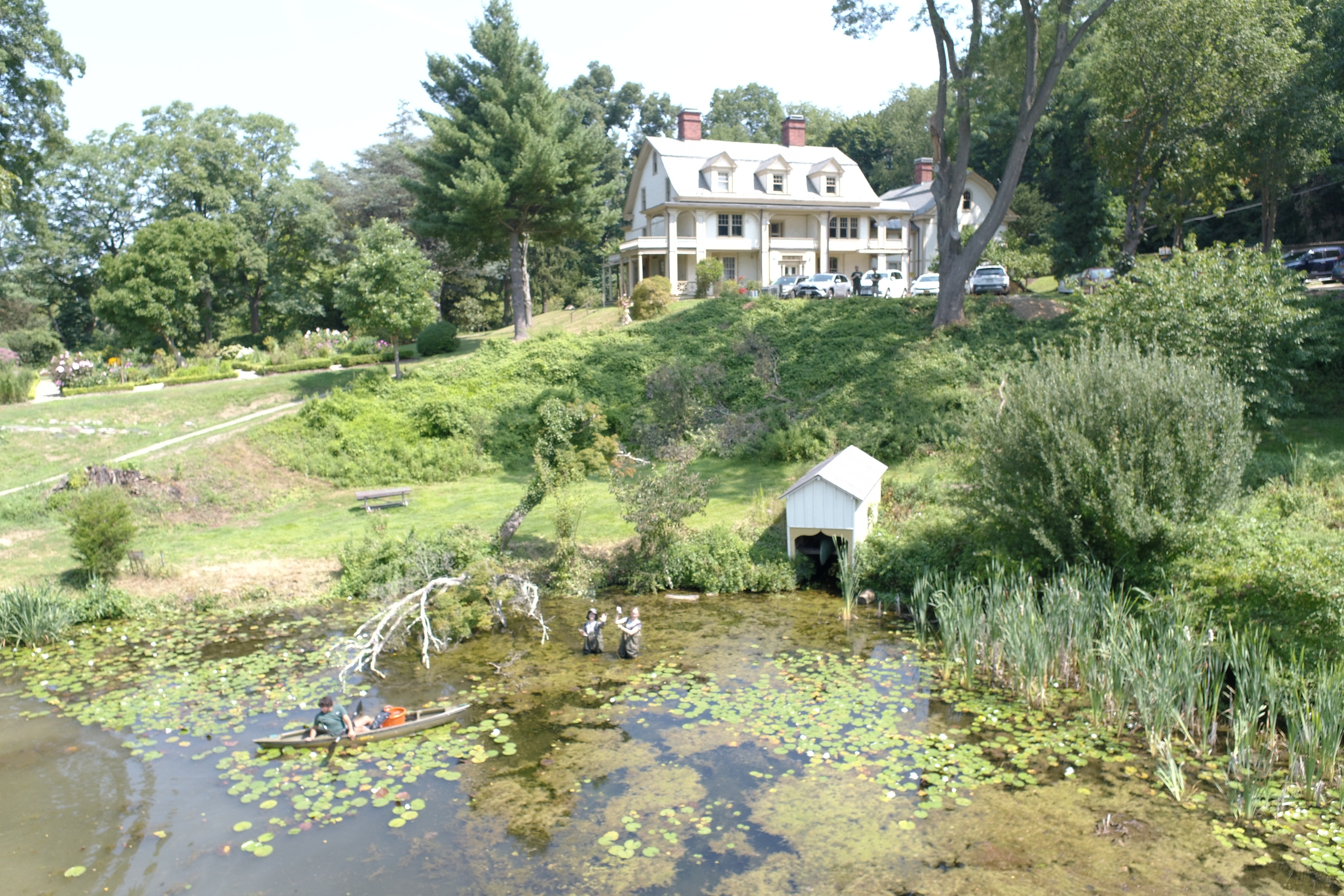
TOH Conservation & Waterways Survey Hempstead Bay
Hempstead Bay is an important resource for marine life and the local economy. After a significant decline of the hard shell clam population following the opening of harvesting in 1978, the Town of Hempstead Department of Conservation and Waterways has been running a successful shellfish restoration program for over 40 years. This recovery was shown in a 2022 shellfish population inventory, showing an abundant variety of flora and fauna.
The project's long-term monitoring will help ensure sustainable management and inform future conservation strategies. This benefits not only commercial shellfisheries but also the entire ecosystem of Hempstead Bay.
To accomplish this goal, Town conservation staff equipped a vessel with sampling and diving gear. For each surveying event, 300 samples will be collected from 100 stations throughout Hempstead Bay. Data collection will be repeated every three years as part of a long-term monitoring program.
This project aims to continually monitor the population of shellfish and seagrass as long-term environmental changes are expected to result from the planned 2025 completion of the Bay Park Sewage Conveyance and unknown changes resulting from climate change and ocean acidification.
NCSWCD Rain Gardens Project
The Nassau County Soil and Water Conservation District continued its goal of restoring and protecting Rain Garden sites across the county. This year's project was spread across every township in Nassau County, with sites at the Town of Hempstead's Hempstead Plains Preserve and the Town of Oyster Bay's Waterfront Center. These rain gardens are equipped with signs describing the native plants that inhabit them, giving the public more opportunities to connect with the green spaces. Additionally, District technician Sean Rooney has provided educational presentations to libraries and garden clubs in the Town of Hempstead and North Hempstead, teaching homeowners about how to build rain gardens and the value they add to a landscape.
Hydrodynamic Modeling in Hempstead Harbor
The Hempstead Harbor Protection Committee has recently secured funding to conduct a shellfish seeding program for all of the north shore bays in Nassau County. Over the next 3 years, CCE Suffolk County will be growing 6 million "spat-on-shell" oysters for this program, of which 2 million will be placed in Hempstead Harbor. This Hydrodynamic modeling will complement a successful oyster gardening project to be carried out by the Coalition to Save Hempstead Harbor.
To build a stable population of oysters, they need to be placed in suitable underwater lands where there is at least 20% gravel and shell and less than 25% silt and mud. They must also be placed in areas where the larvae will settle with suitable substrate conditions upon which to attach and grow. A Shellfish Density Survey of the harbor was conducted in 2021, producing a map of ideal locations. To build upon this, a "hydrodynamic modeling" survey was necessary to determine the location of new oyster spawn that are carried by the currents for a week or two before they settle to the bottom. If Oyster larvae are carried out into the Long Island Sound, they will not help populate the harbor, or if they settle in muddy areas, they will most likely not survive. Hydrodynamic Modeling looks at the tidal cycles, water current velocity, water current direction, underwater land composition, and several 24-hour water quality parameters, such as dissolved oxygen levels (since oxygen levels drop at night). After the completion of this modeling, a habitat suitability map will be derived showing the most suitable "source" (planting) and "sink" (settling) areas.
Shellfish are known as a "keystone species," forming the basis for an entire marine ecosystem that would not exist or would be fundamentally changed without them. Oyster reefs not only provide food and a habitat for numerous species but also protect shorelines from storm damage and erosion. They also improve water quality by removing nutrients such as nitrogen that contribute to algal blooms and oxygen depletion. A single adult oyster can filter up to 50 gallons of water a day. At that rate, 2 million oysters would be able to filter over 100 million gallons a day.
Town of Oyster Bay Dune Day
The Town of Oyster Bay, Department of Environmental Resources serves 300,000 residents and 169 square miles of natural resources, including waterways, wetlands, forests, wildlife, animal rescue, air quality, soil quality, and waste disposal. The Department is devoted to environmental outreach, collaboration with, and education of the public, to enhance environmental restoration efforts and work towards the universal goal of environmental stewardship.
The NCSWCD helped fund part of the replacement of dune grass that was lost during recent heavy storms and hosted a Dune Day event. With the District funding, the Town would purchase approximately 464 bundles of dune grass. The second Dune Day will be held in October, as dune grass is most effectively planted in the spring or fall seasons. On March 30th, 2024, the Town of Oyster Bay hosted its annual dune grass planting event at TOBAY Beach, drawing over 150 volunteers who planted four pallets of native dune grass stalks across 2.7 acres of Atlantic Ocean dunes. The Town has planted 1,000 bundles (containing 100 grass plugs each), equating to 100,000 individual plugs of American Beach Grass. This will help stabilize the shoreline sand against heavy winds and assist with the absorption of water.
The Long-term benefits of replanting dune grass extend beyond immediate erosion control, providing sustainable advantages for the coastal environment and community. By stabilizing the dunes, dune grass supports biodiversity, creating habitat for shorebirds that depend on these beach habitats for nesting and foraging. Healthy dune ecosystems contribute to climate change resilience by acting as natural storm surge buffers and rising sea levels. By absorbing wave energy and reducing the impact of future storms, dune grass helps protect nearby infrastructure such as Ocean Parkway and ensures the long-term viability of the coastline. The Town of Oyster Bay is committed to promoting environmental stewardship and raising community awareness through environmental newsletters, social media, and press releases.
Town of North Hempstead - Native Plant Rebate Program
The Town of North Hempstead is a densely developed suburban community located in the western portion of Long Island. The TONH Environmental Resources Department was funded by NCSWCD to reimburse town residents who purchased native plants to create gardens. Native plants provide food, shelter, and nesting resources for pollinators, as well as birds, small mammals, and a variety of other wildlife species. They also have a multitude of environmental benefits like extensive root systems that absorb polluted stormwater (especially when used in rain gardens), the ability to take in carbon dioxide and other air pollutants, lower maintenance requirements, and less need for inputs like fertilizer use, mowing, and irrigation.
The Town is committed to helping wildlife regain lost habitat using native plants and has planted many native plant gardens in its landscapes. Read more about these plantings here. Town of North Hempstead Native Plants
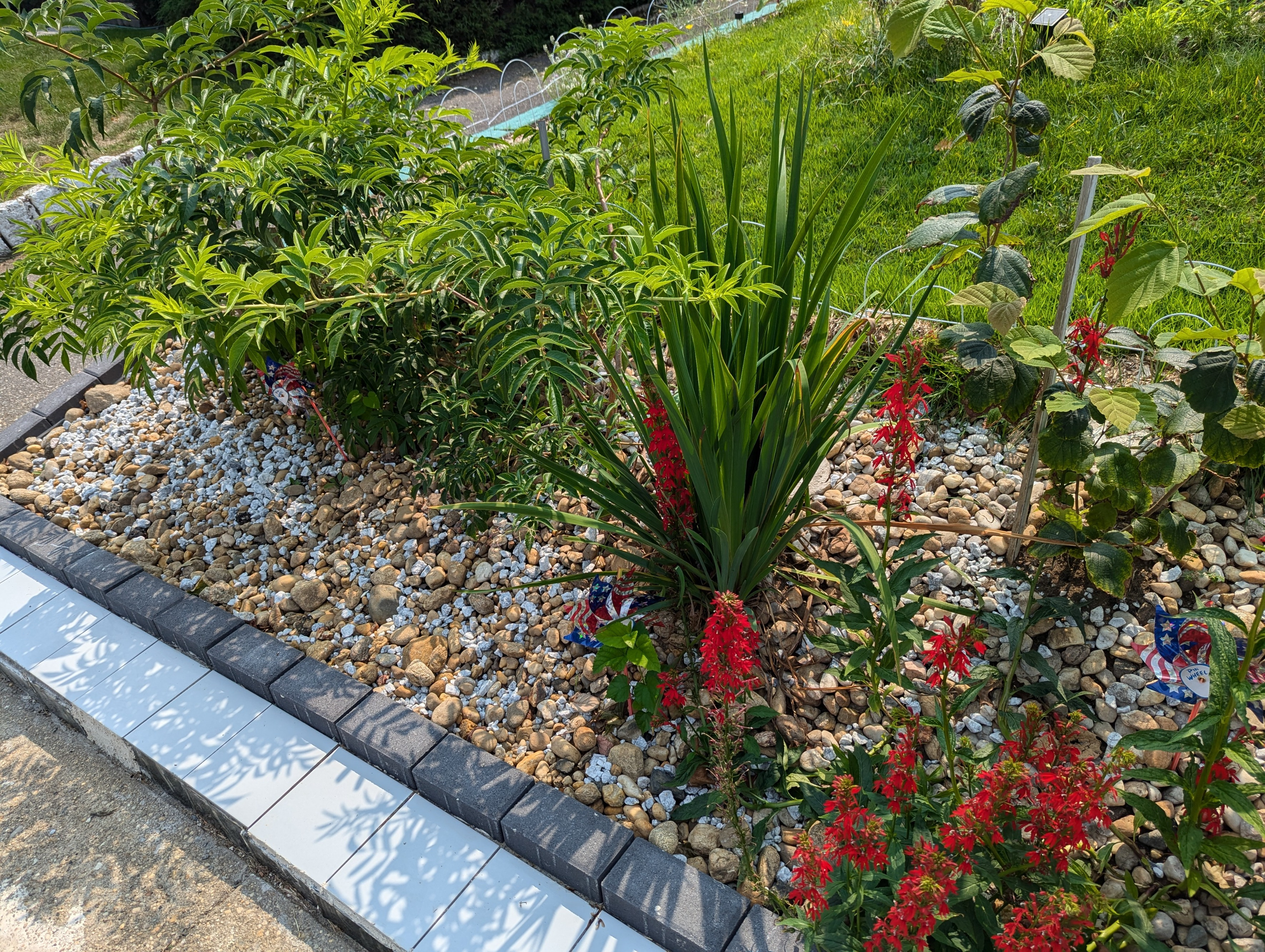
Part C Projects 2023
The Reintroduction of Fire at the Hempstead Plains: An Opportunity for Change
The NCSWCD provided funding to the Friends of Hempstead Plains for their project to preserve, restore, and manage the Hempstead Plains prairie habitat on the campus of Nassau Community College. The Hempstead Plains Preserve is the last, best remaining Long Island Tallgrass Prairie, including over 200 plant species, 14 rare species. Funding from the NC Conservation District will help supplement outreach and educational programs.
Restoration via mowing, tree cutting, herbaceous plant cutting, herbicide treatment, etc., is already happening; however, prescribed fire, a necessary control component, has not been used at the Hempstead Plains since the 1990s. This Part C funding would allow the Friends to study the prairie’s response to prescribed fire this coming April. The area scheduled to be burned in 2023 is a 4-5-acre section of the Hempstead Plains Grassland community dominated by little blue stem and goldenrods, with pockets of successional scrubland habitat, and general overgrowth. It also includes the 1-acre plot in which the globally endangered Sandplain Gerardia grows, which is a fire-dependent species. The surveys will allow the Friends to select a 2024 burn location and create an invasive species removal plan for the 2023 burn area.
Cedarmere Preserve: Removal of invasive species and hydroseeding with mix of grasses and wildflower species.
In 2014, the Friends of Cedarmere began a program aimed at the removal and control of invasive species of plants and trees and the planting of native species. This work was supported in part by funding from NCSWCD. Many hundreds of native trees and shrubs have been planted and established over the years, but excessive growth of invasives threatens these plantings every growing season. Hundreds of invasive trees of all sizes in natural areas, such as Norway maple, tree of heaven, and Japanese maple have been removed.
This project plans to make a more ambitious effort to remove invasives in certain upland areas, where we will also add hydroseeding with native grasses and flowers to help control invasive ground cover plants such as English ivy. For all of this work, the services of Spadefoot Design and Construction were utilized. Their specialized knowledge and equipment used for this work are expected to give us the best results. We used the services of Spadefoot for invasive plant removal in selected areas over the past two years. This year, they will be employing some additional mechanized equipment, where feasible, plus the addition of hydroseeding. Overall, the project areas covered a total of 20,000 ft sq.
The seed mix used: 20% Virginia Wildrye, 19.8% Big Bluestem, (18.9% Little Bluestem, Indiangrass), 13% Switchgrass, 2.8% Partridge Pea, 2.5% Blackeyed Susan, (1.4% Oxeye Sunflower, Showy Ticktrefoil), (> .2 % Common Milkweed, Wild Bergamont), (>.1% Heath Aster, Roundhead Lespedeza, Narrowleaf Mountainmint, Canadian Goldenrod)
Science Museum of Long Island: Leeds Pond Preserve Forest Restoration
The Science Museum of Long Island (SMLI) is a non-profit, science activity center that has been providing science education on Long Island since 1962. With programs designed to help stimulate children’s interest in science through hands-on learning, helping children understand and gain a greater respect for the environment and natural world.
Our campus, located on the 36-acre Leeds Pond Preserve, is the core of our educational programs. The varied habitats, from open fields to intertidal beaches, natural forests, and riparian marshes, are our outdoor classrooms, most notably for our Summer Science Camp and after-school workshops. While the property is home to SMLI, all of Nassau County’s residents can visit and benefit from this publicly owned preserve.
The Science Museum of Long Island was awarded $15,000 in grant funding to be used for site reforestation and woodland restoration at our facility in Manhasset at the Leeds Pond Preserve. This funding was met with an equal match and used for the purchase and installation of over 325 native plants for the restoration of a 12,500 square foot area. SMLI's goal is to stabilize and restore soils and provide food sources and ground cover for wildlife in a degraded area of forest within the Preserve. Through physical site restoration (absence of any pesticides or herbicides), invasive and undesirable species were eliminated or greatly reduced. In an effort to mimic a young forest consisting of trees, shrubs, and groundcover, reforestation featured varied sizes of plants with ample spacing, allowing light penetration and promoting natural restoration through the existing seedbank in the soil. Temporary irrigation was used to ensure survivability and will be actively monitored to eliminate unwanted erosion. Historically, the restoration area has been negatively impacted by a variety of invasive species. Invasive plants like Kudzu and Japanese Knotweed have historically outcompeted or overtaken native vegetation, in turn pushing out native species of wildlife, including birds and mammals. This reforestation project was designed specifically to ensure that these aggressive invasive species do not return or gain a foothold. The restoration project will be used as part of our outdoor classroom learning experience, with children and adults being able to see the project from start to finish and be educated on the importance of native plants and how individuals can make an impact through invasive species removal.
Garvies Point Museum and Preserve Meadow Restoration
The Garvies Point Museum and Preserve are operated by the Nassau County Department of Parks, Recreation, and Museums. The preserve consists of 62 acres of glacial moraine covered by forests, thickets, and meadows. There are approximately five miles of marked nature trails, including those for the visually impaired. Wooded areas, which exhibit various stages of succession, contain over 60 species of trees as well as numerous shrubs, vines, and wildflowers. High cliffs along the shoreline display erosional features such as alluvial fans, talus slopes, and slumping caused by ancient multicolored clays oozing from the bluff. The woods and meadows, with their varied plant life, attract more than 140 species of birds, notably scarlet tanagers and many varieties of warblers. Woodchucks, opossums, and raccoons can occasionally be seen in the woods or along a meadow's edge. The preserve supports woodland communities of differing ages and composition. Their development is related to prior land use, which included cattle grazing, hay harvesting, and timber cutting for lumber, firewood, and fence stock. In the early 1900s, most of the preserve and the surrounding lands were meadow and pasture. As less open land was needed for cattle and agriculture, the area reverted, through natural succession, to woodlands, resulting in forest communities of varying ages. The land was acquired by Nassau County in 1963, with the museum opening on July 4, 1967. The museum specializes in New York State and Long Island geology and Native American culture and archaeology, with an interactive "woodland village" with activities depicting Native American life-ways, while also providing an extensive outdoor classroom where the public can learn about the natural systems and communities that existed prior to settlement.
This project aimed to enhance and restore soils by removing invasive species such as porcelain berry, mile-a-minute, and mugwort, then planting approximately 750 native grassland plugs consisting of 5 native grassland species. Planting native species establishes a diverse root system that provides erosion control, improved stormwater infiltration, and increased nutrient uptake, resulting in healthier soils for insects and small mammals.
Community Outreach and Eduation
The NCSWCD participated in local and regional forums to assist with conservation education and outreach and to better understand current environmental conditions as they relate to Nassau County.
Additional events and meetings include:
NYS Open Space Planning, Long Island Nitrogen Action Plan, Conservation District Employees Association, Re-Leaf, DEC Water Chesnut Pull, Long Island Native Plant Initiative Grasslands Symposium, National Onsite Wastewater Recycling Association Conference.
NYS ISA Certified Arborist Olivia Cunningham (Pictured Left) teaching Merrick residents proper tree care and identification. A second educational walk was also hosted in Freeport. These two events were in collaboration with Wild Ones, a nonprofit focused on promoting environmental education and conservation programs on Long Island.
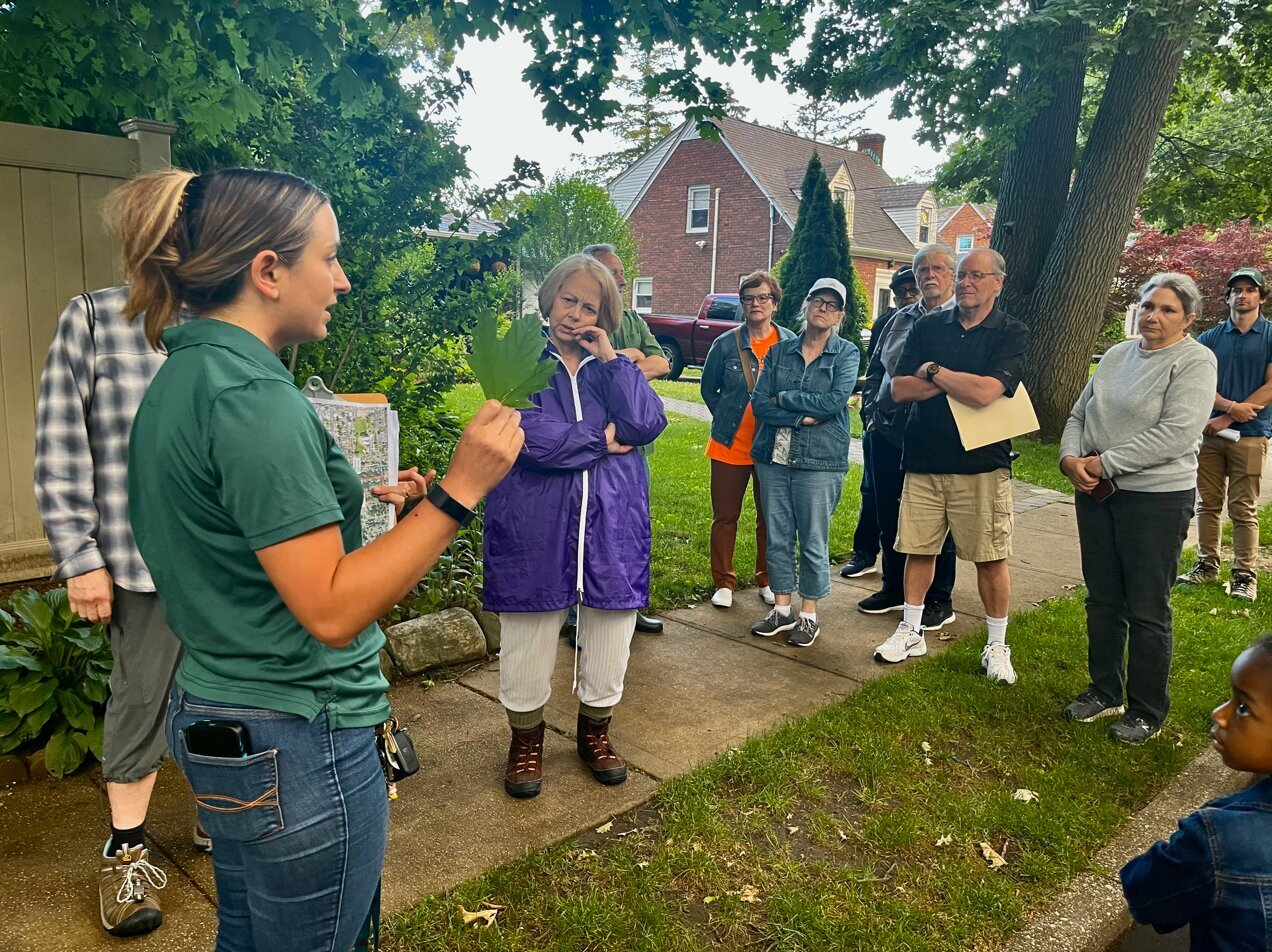
Part C Projects 2022
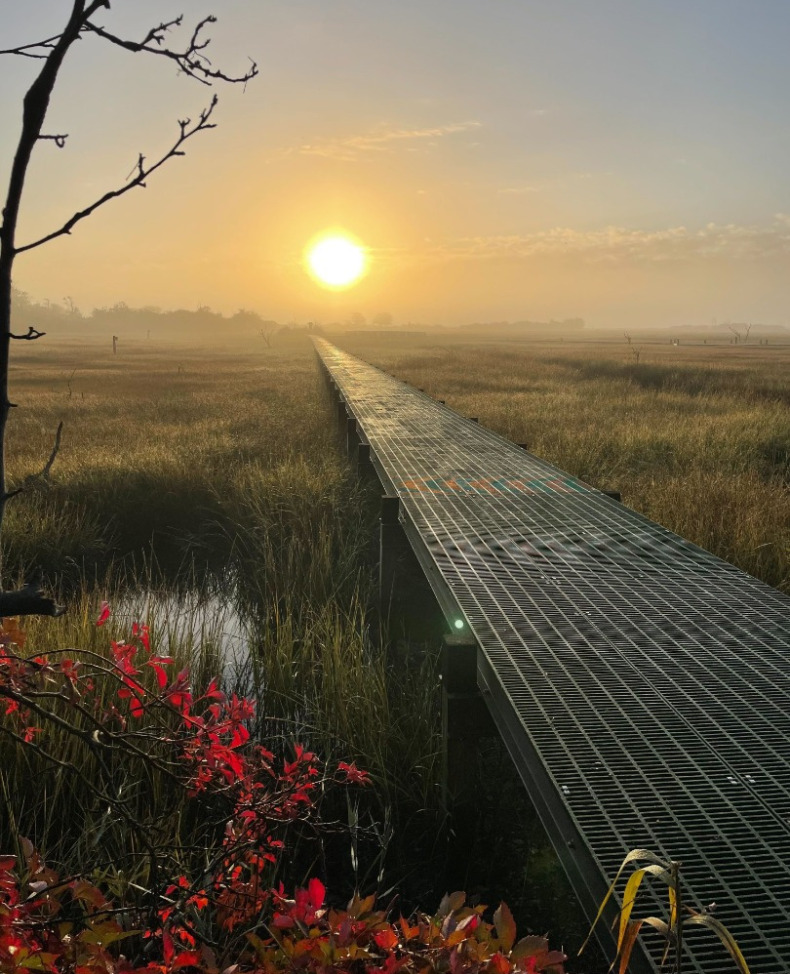
A Day in the Life
A Day in the Life is a program organized by the South Shore Estuary Reserve focused on environmental education, community engagement, and water-quality monitoring. Students will get the opportunity to collect water quality samples, learn about ecosystem services, and engage with local flora & fauna.
After the field trip event, the data collected by student groups is processed and shared for analysis, an activity in which students are encouraged to participate. This can range from tracking water & soil health throughout Nassau County to GIS analysis of the collected data.
Nassau County SWCD Rain Garden Revitalization Project
The purpose of a Rain Garden is to capture excess stormwater runoff and filter it of pollutants as it enters the groundwater system. Rain Gardens are a type of green infrastructure, using native plants with extensive root systems that capture and clean water as it passes down their roots.
The NCSWCD has built numerous gardens over the years. The locations include Nassau Hall in Muttontown Preserve, Bayville Community Center, Bayville West Harbor Beach, Bayville Eastern Waterfront Center, and the Hempstead Plains Nature Preserve on the NCC Campus.
Initial Characterization of Management of Pathogens Affecting Sanitary Condition of Shellfish Lands in the Oyster Bay-Cold Spring Harbor Complex
The NCSWCD provided funding to Cornell Cooperative Extension (CCE) to collect water quality data that will then be used to identify problem areas and manage fecal coliform contamination in the watershed.
The project was broken into four parts, with the main goal to use data collected to guide efforts to identify problem areas and manage fecal coliform contamination.
- Existing data from shellfish land areas and available NYS DEC Shellfish sanitation data were compiled and analyzed according to U.S. FDA National Shellfish Sanitary Program recommendations.
- Training of Oyster Bay-Cold Spring Harbor Protection Committee Members and Volunteers in illicit discharge detection and elimination (IDDE): This training will ensure the continuation of IDDE after the project is complete
- Project Profiles for Future Study and Management Strategies Addressing the Most Contaminated Sites Identified in the Cold Spring Harbor Watershed
- Storm Sewer Mapping and Identification of Major Drainage Areas in the Mill Neck Creek Watershed and Planning for Future Fecal Coliform Assessments
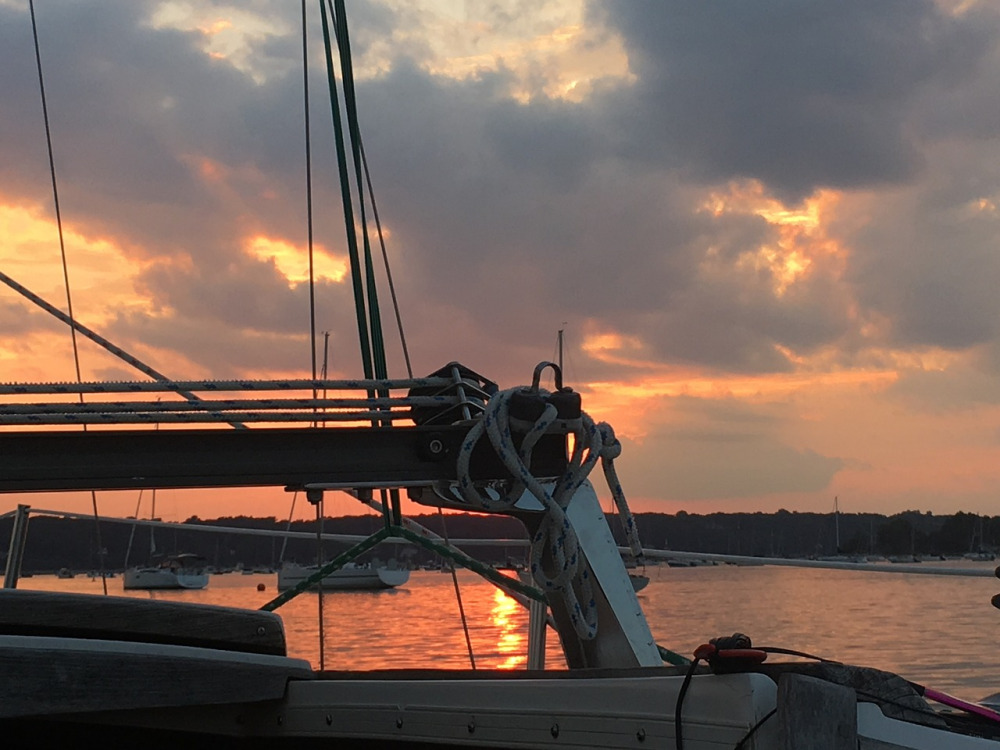
Habitat Restoration at Leeds Pond
The Invasive Plant Removal and Native Plant Revegetation of Leeds Pond Preserve was made possible with funding from the Nassau County Soil & Water Conservation District. The Science Museum of Long Island worked with Spadefoot Design and Construction to complete the project with the goal of clearing 2 acres of Invasive plants like Japanese Knotweed, English Ivy, and Norway Maple and replanting with resilient native species.
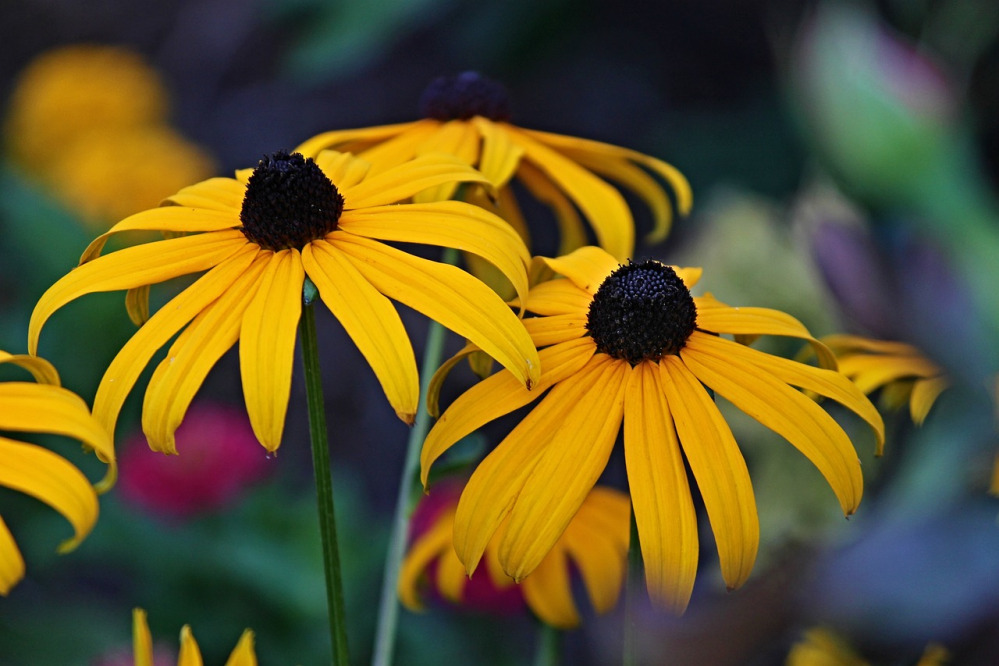
Town of North Hempstead - Native Plant Rebate Program
The NCSWCD provided funding to reimburse Town of North Hempstead Residents who purchased native plants to create native plant gardens and rain gardens. Native plants provide food, shelter, and nesting resources for birds, pollinators, small mammals, and a variety of wildlife species.
Native plants have a multitude of environmental benefits, like extensive root systems that absorb polluted stormwater, sequestering carbon, lower maintenance requirements, and less need for fertilizer, mowing, and irrigation.
Providing rebates for the installation of these plants would lead to more native plants being put into the ground, which will support the Town's effort to increase native plants and wildlife habitat throughout the Town of North Hempstead.
Shorescaping at Baxters Pond
Repairing and replacing the riparian buffer along the shores of Baxter's Pond.
Bordered by a densely suburban community and 2 highly trafficked roads, Baxter's Pond is the catch basin for debris, runoff, litter, and chemical waste from lawns and road care. Baxter's Pond is spring-fed and flows directly into Manhasset Bay, eventually feeding into the Long Island Sound
The "Shorescaping" Project will address the need to abate nonpoint pollution sources reaching Manhasset Bay, increase and improve the natural resources with native plantings, and remove invasive plants.
The project, funded by the NCSWCD, began in 2019 and has supported a multi-year design and planting program. The Baxter's Pond Foundation has engaged volunteers to assist in the planting process and educate about native plant choices.
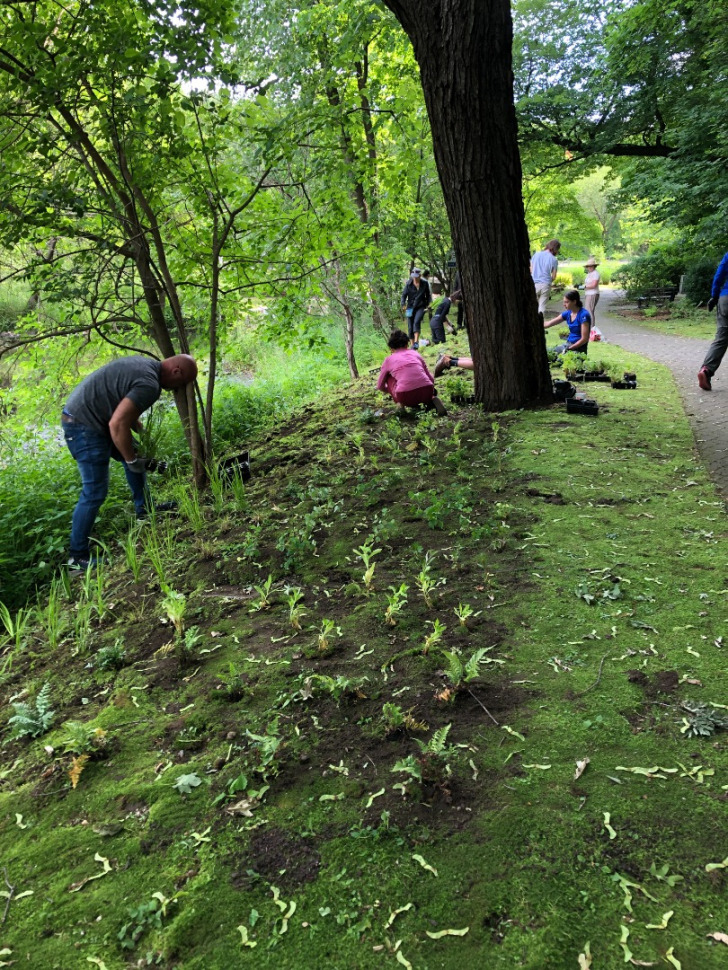
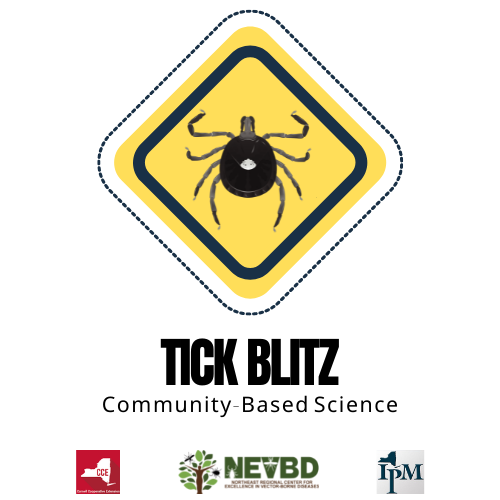
Participating in the 2022 TICK BLITZ
The NYS Tick Blitz is a yearly event created by the Northeast Regional Vector Control Center NEVBD. With help from Cornell Cooperative Extension CCE and NYS Integrated Pest Management NYIPM. Read about the NYS Tick Blitz here
The purpose of the study is to study all NY regions simultaneously to understand where different tick species are present and track their northward expansion. District Technician Sean Rooney surveyed a collective 1,500 meters of Muttontown Preserve.
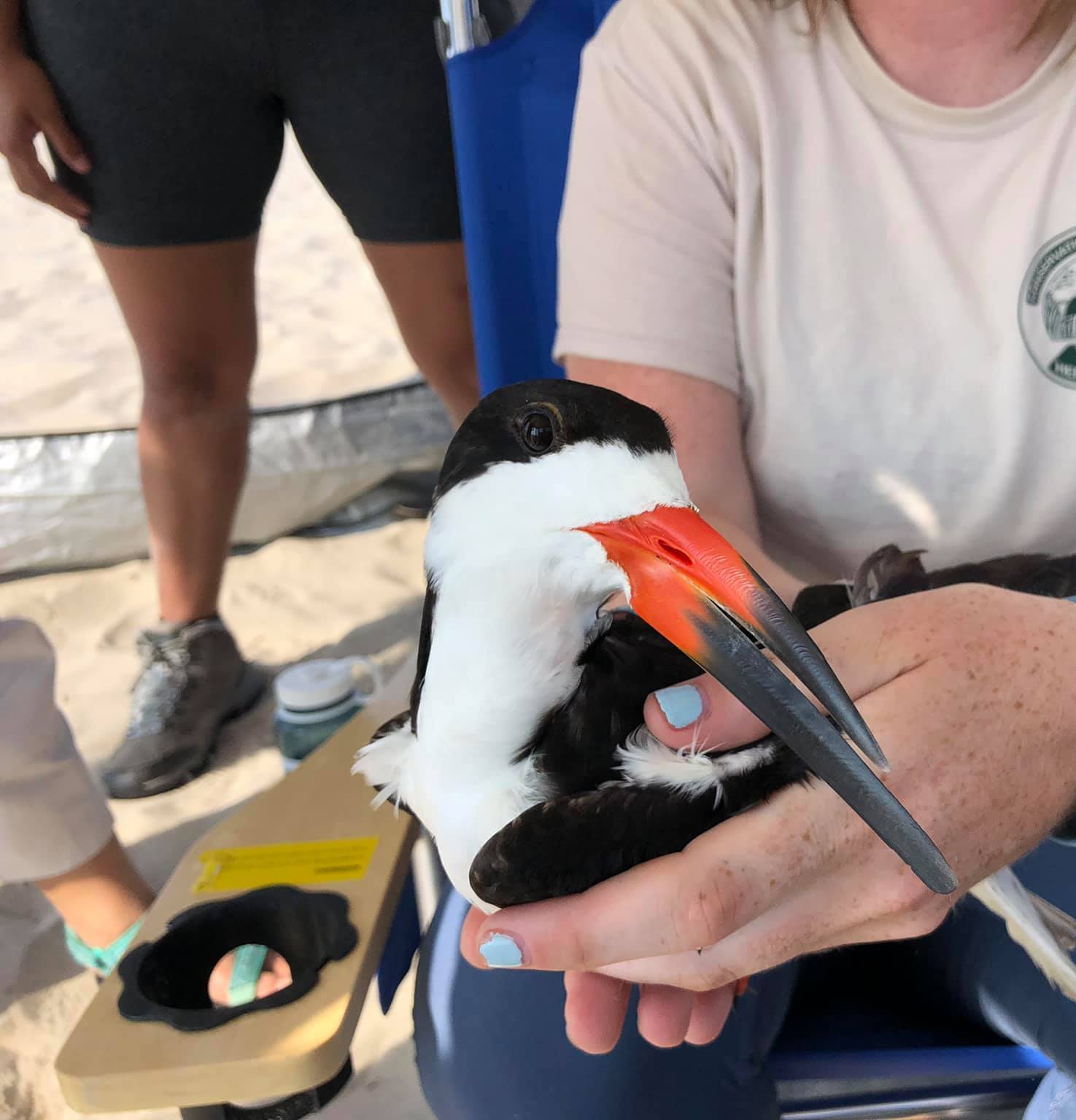
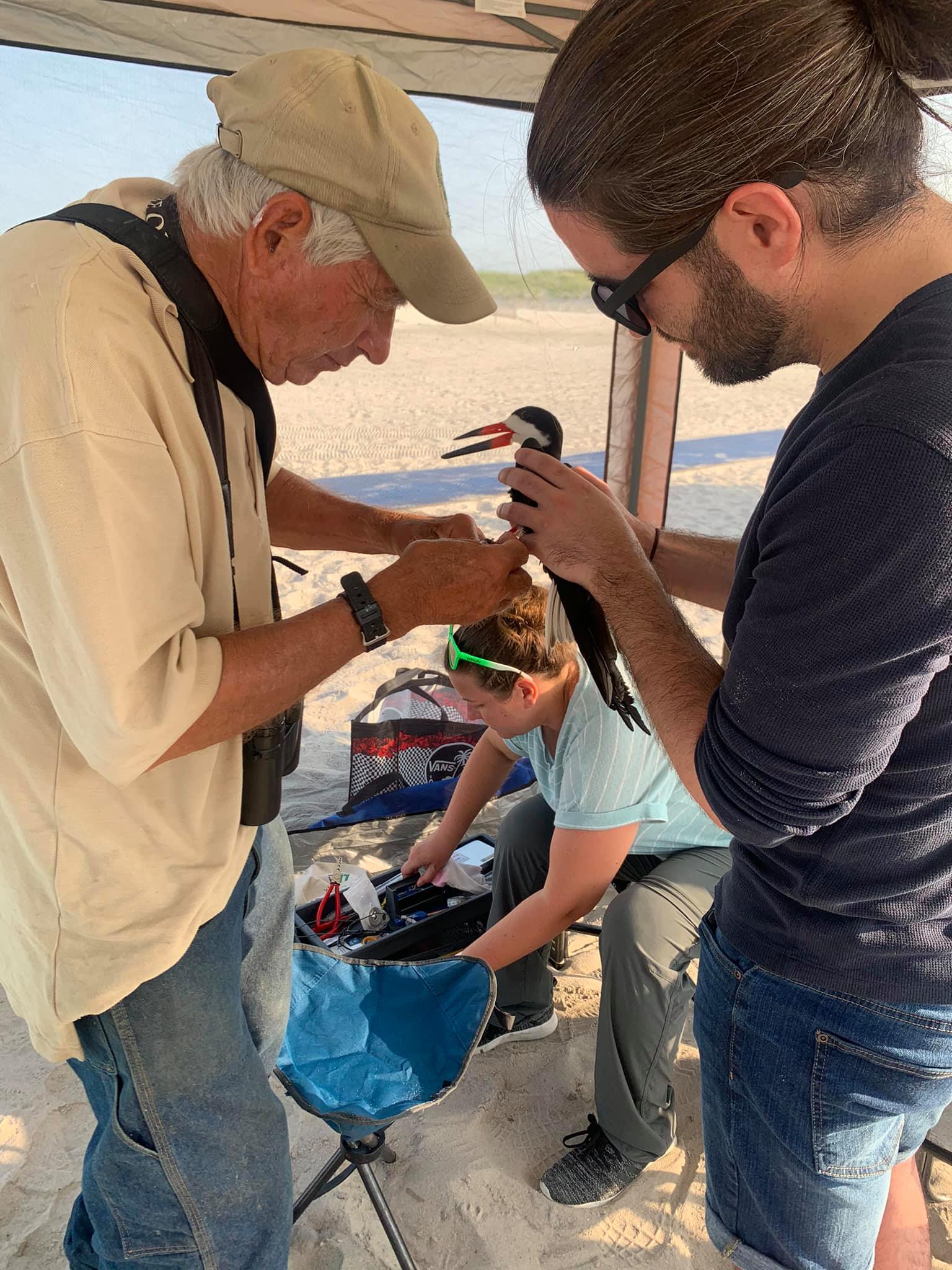
Black Skimmer Monitoring
Black Skimmers are a prominent species of migratory seabirds found on Long Island's South Shore and were at the center of two NCSWCD projects.
Kate Robb from the Town of Hempstead's Department of Conservation & Waterways managed a citizen science project that surveyed beachgoers about their knowledge and interest in ethical wildlife photography. The survey resulted in 50 Skimmer photo submissions from photographers!
The District also assisted with bird-banding events at Nickerson Beach in partnership with the University of Oklahoma's Aerocology Group in an attempt to better understand the species' migratory habits.
Water Quality
Water quality is inherently important in a place like Long Island, where we drink from the groundwater collected in our aquifers. There are many moving parts that contribute to good water quality. Green Infrastructure, like permeable pavement and rain gardens, can help increase the amount of water infiltrating into the ground, recharging our aquifers. Being surrounded by water, coastal erosion and accretion are in a constant flux. The Nassau County Soil & Water Conservation District helps prevent these issues with various green infrastructure projects.
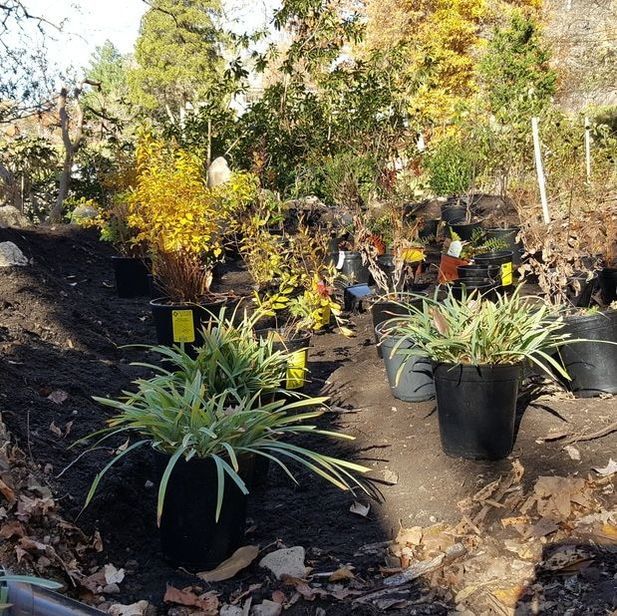
Planting for Clean Water
Nassau County SWCD helped build Rain Gardens with the help of a grant from the National Fish and Wildlife Foundation. Helping reduce pollution and excess nutrients carried by stormwater. These gardens were strategically located in areas with impermeable surfaces to collect the most stormwater runoff.
Ecological Restoration at Mill Pond
Nassau County SWCD helped restore the coastline at Mill Pond by removing invasive plants threatening the health of the coastline. The area was replanted with Spartina alterniflora, also known as cordgrass (an essential native deciduous grass that is a perennial found in many intertidal wetlands), to help reduce erosion and improve water quality.
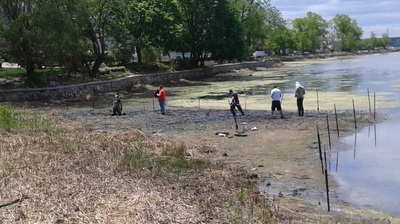
Seeking Volunteers & Interns
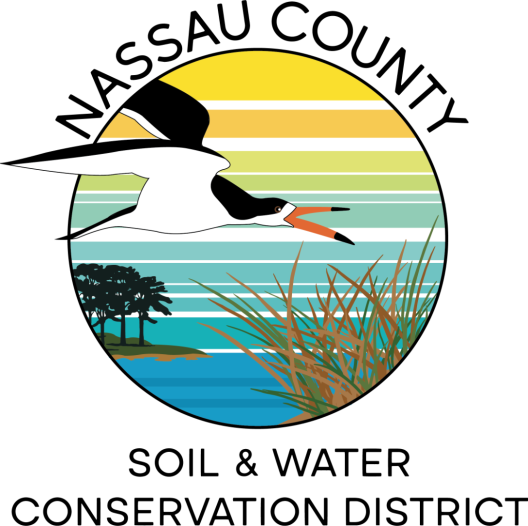
Interested in protecting your local resources? Looking for a chance to give back to your community?
The Nassau County Soil and Water Conservation District is currently seeking volunteers to help implement various environmental projects. No experience required. Weekend opportunities available.
Historic Projects
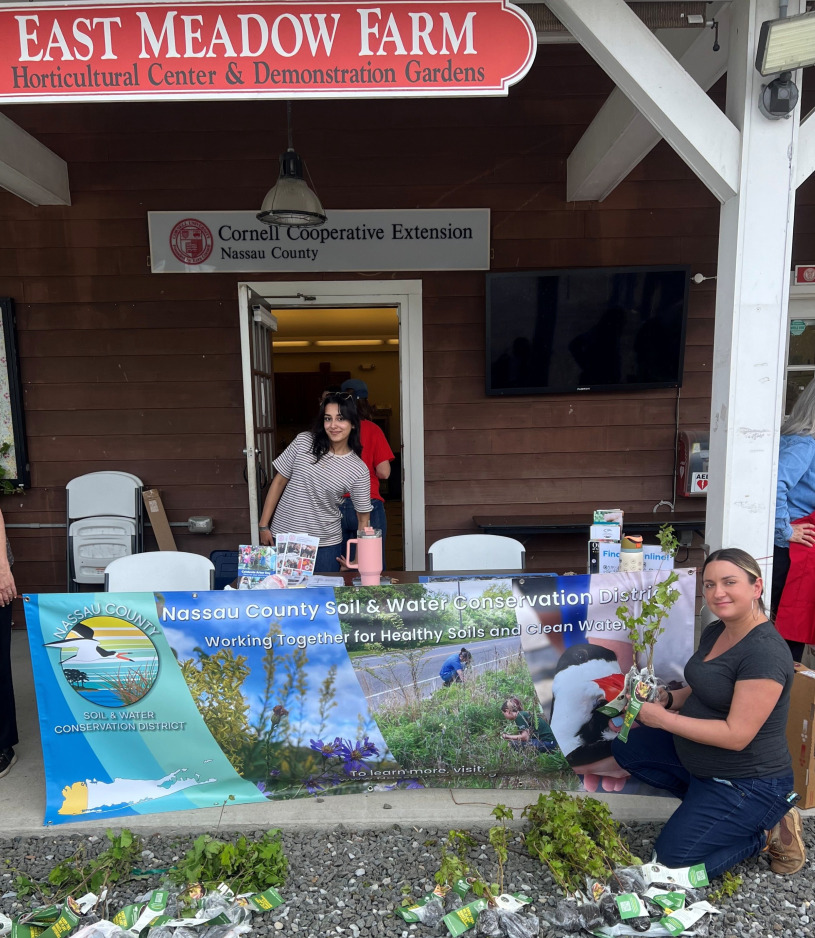
Hosting our annual sapling giveaway!
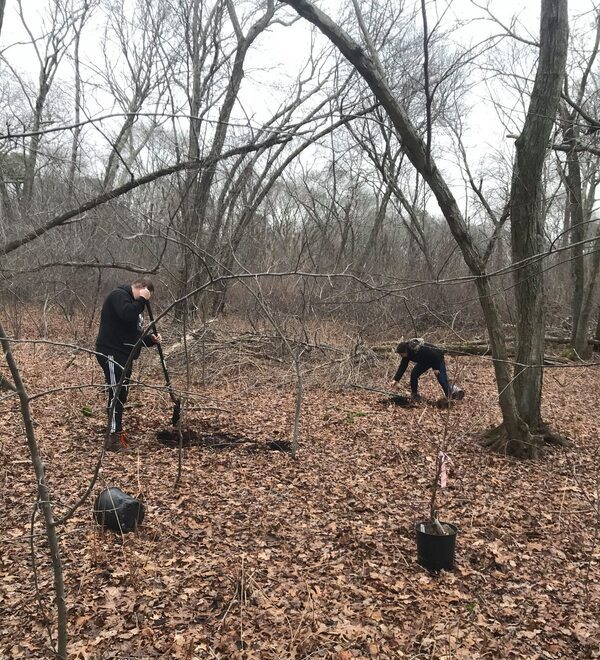
Planting 100 trees at the Massapequa Preserve 2019
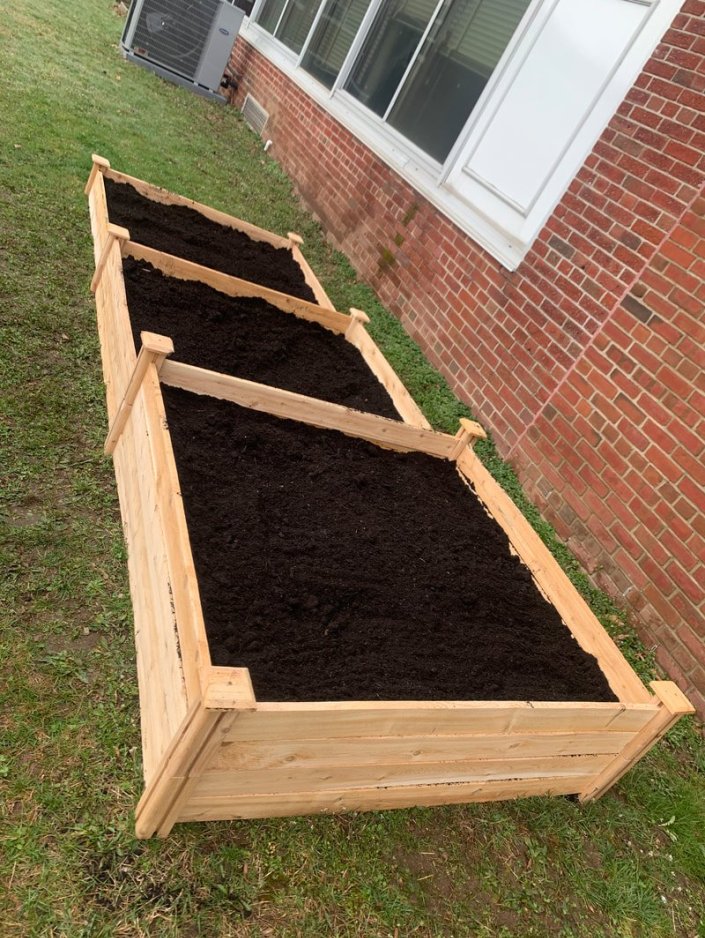
Building plant boxes at the Hicksville School District. 2019
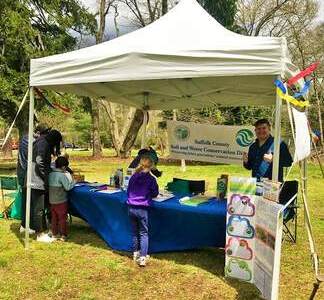
Tabling at The Eco Carnival. 2019
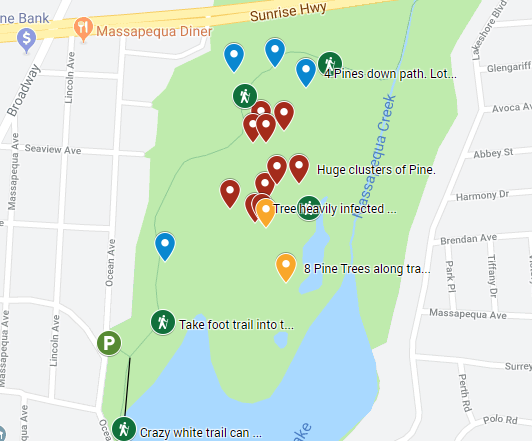
Mapping out high-risk Pine Trees for Southern Pine Beetle Infestation. 2019
Press Releases
2015
- Scudders Pond Press Release
- National Grid Hosts Earth Day Event with Nassau County Soil and Water Conservation District and Builds a Rain Garden at the Largest Nature Preserve in Nassau County
2014
- Mangano: Tree And Shrub Sale To Help Beautify Neighborhoods Damaged By Hurricane Sandy And Winter Storms
- Tree and Shrub Sale to Beautify Nassau County
2013
- Post-Sandy Tree and Shrub Seedling Bulk Buying Program Announced
- Supporting Cost-Effective Green Technology
2012
- Protecting our Future inside a Piece of History














